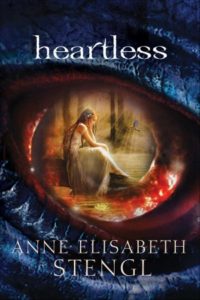With the release of Heartless (Bethany House), author Anne Elisabeth Stengl welcomes readers young and old into a magical and mysterious world infused with Tolkien-esque sensibilities and a strong dose of dragons. In the tradition of Donita K. Paul or Bryan Davis, Heartless is an exciting read full of action, adventure, and romance.
Where did the idea for Heartless come from?
 I started out writing Heartless as a short story which I posted in small parts on my blog. I was surprised at the reader-response to the plot–a lot of enthusiasm and curiosity about where I was taking it. Intrigued by the general reaction to the storyline, I decided to not finish the short version but started to work on a full-length novel.
I started out writing Heartless as a short story which I posted in small parts on my blog. I was surprised at the reader-response to the plot–a lot of enthusiasm and curiosity about where I was taking it. Intrigued by the general reaction to the storyline, I decided to not finish the short version but started to work on a full-length novel.
Did you encounter any interesting challenges while writing/researching for Heartless?
There is a surprising amount of research that goes into writing a fairy tale, even though it is set in my own invented world. I already had a strong working knowledge of fairy tales, but while writing this novel I kept my volumes of Shakespeare and Edmund Spenser close for reference. Many of the classic symbols and themes found in Heartless are derived from these sources rather than Grimm’s Fairy Tales. I also had fun researching fencing for certain scenes involving the character of Felix, my heroine’s brother.
At first, I simply read manuals on fencing and a few classic swashbuckler novels such as Scaramouch. Later on, I started taking fencing classes myself, which has turned into an exciting hobby! I met my soon-to-be husband at fencing class. He is an excellent fencer, truly skilled–though I have beaten him in our only “official” bout thus far!
Is there an underlying message to the novel?
 Heartless is, on the surface, a simple fairy tale: it’s about a silly young princess who simply wants to marry a handsome prince. But when her dream is stolen—along with her heart—the story takes a much darker turn. This is a book about succumbing to despair through disappointment. It is about the death of dreamswhich kills the spirit. It is also a story about letting go of the dream and the bitterness, both of which are chains on the spirit.
Heartless is, on the surface, a simple fairy tale: it’s about a silly young princess who simply wants to marry a handsome prince. But when her dream is stolen—along with her heart—the story takes a much darker turn. This is a book about succumbing to despair through disappointment. It is about the death of dreamswhich kills the spirit. It is also a story about letting go of the dream and the bitterness, both of which are chains on the spirit.
Almost every author puts a little of themselves into their stories–what did you put of yourself into this one?
I think a little of myself went into each one of the characters, but particularly my heroine. Una is a silly, day-dreaming, cat-loving girl who stutters when she’s nervous, spats with her brother, and writes very bad poetry–which is basically me. But she is simultaneously an “everyman” type of character that many girls will find very relatable. Several of the characters are lightly based on people I know–or they are based on my perspective of people I know, which ultimately makes them more a part me than anybody else.
What stands out about your characters? Do any of them embody unusual personality or physical traits?
My characters are very real people, despite living in an other-worldly setting. Some of them are intriguing in appearance–Monster the cat has no eyes; Sir Oeric is as ugly as a goblin though he is a noble knight—while others are quite plain looking. Prince Aethelbald, my hero, is described as the most unnoticeable man my heroine remembers ever meeting–though she may have met others without noticing. Prince Gervais, one of Una’s suitors, is distinctly “not handsome,” but is so charming that no one realizes the fact.
For the most part, however, I don’t spend time describing the physical appearances of my characters, but let their personalities create distinct images of them in my readers’ minds. Felix is a snarky tease who loves his family and is embarrassed to show it. Leonard the jester is all laughs, jokes, and self-deprecation but these are masks to cover a deep-rooted pride. It is these kinds of characteristics that make the people of my novel distinct.


